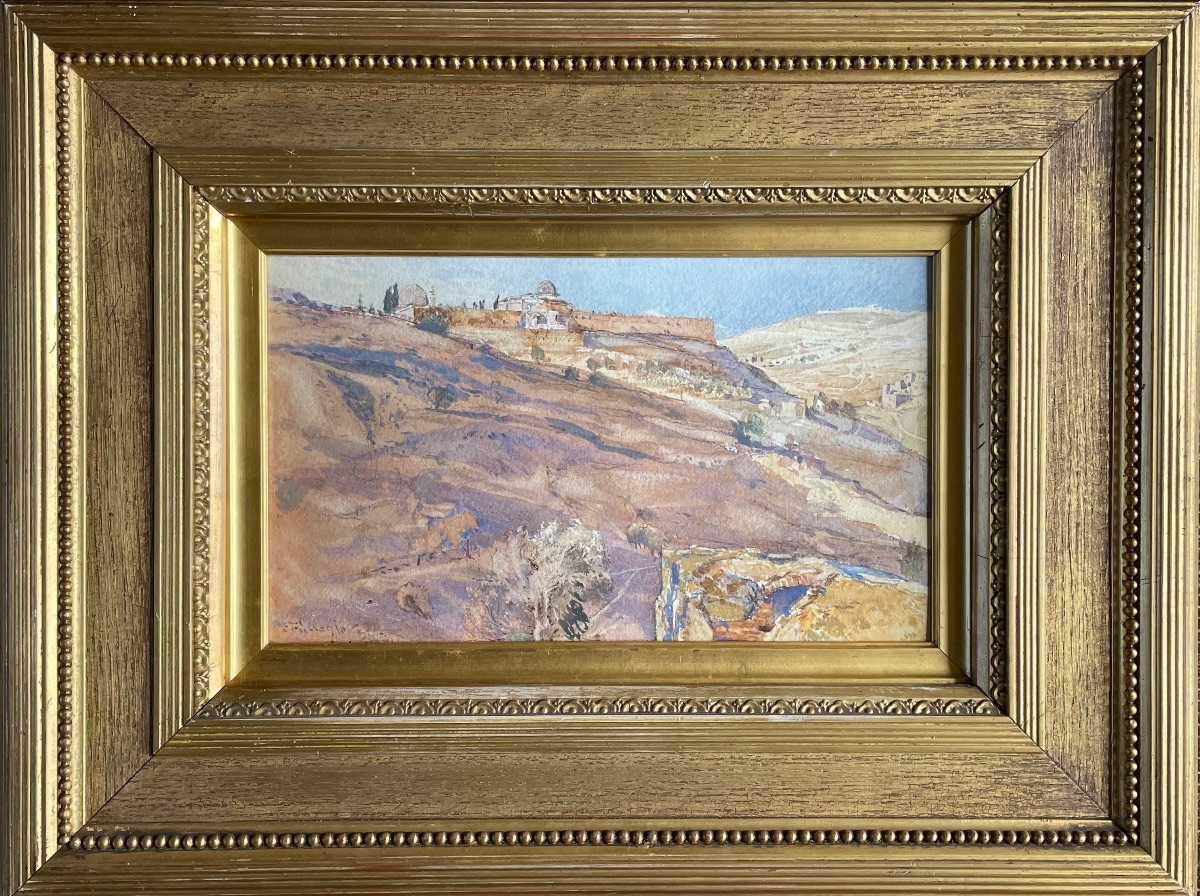
Jerusalem – South Wall of the Temple Area, from the Valley of Hinnom, at Sunset, by John Fulleylove (184). Watercolour on paper. 5 ½ x 9 inches (13.5 x 23 cm). Private collection. Image courtesy of Sarah Colegrave Fine Art.

Illustration to The Holy Land.
In 1901 Fulleylove travelled to Palestine to paint views intended to be used as illustrations for The Holy Land, described by John Kelman, and published by A & C. Black in 1902. The book contained ninety-three full-page plates from paintings by Fulleylove, nearly all in colour. This particular illustration is plate 31, opposite page 88. The caption opposite the image reads:
The point of view is from Aceldama, the Field of Blood (Acts of the Apostles, i.19). The ruin in the right-hand lower corner is known as the Building of the Field of Blood: according to tradition it served as a charnel-house for the Crusaders. The valley immediately below is the Valley of Hinnom, that to the right is the Valley of Jehoshaphat or Kidron, with Mount Scopas shewing above, and the north end of the village of Siloam below. The dome of the Mosque of Omar is seen above the south-west corner of the Temple Area. The other dome, above the centre of the wall, is that of the Mosque of El Aksa. The last rays of sunset redden the South Wall and throw a rich purple shadow over the Valley of Hinnom.
The watercolour itself is inscribed on the verso by the artist and beneath the mount, "Valley of Hinnon/Walls of Jerusalem. Solomon's Corner Stone from Field of Blood, 10 April 1901." The colour reproduction illustration doesn't do justice to the watercolour, however, and fails to capture the true purplish tints in the fore- and midground and the bright blue of the sky. The veracity of the landscape shown in the watercolour can be verified when it is compared to other artists' depictions of similar scenes, including those done by Thomas Seddon almost fifty years earlier, such as his Mount Zion or Jerusalem and the Valley of Jehoshaphat. Fulleylove has not treated his landscape with the same Pre-Raphaelite precision, however, and his work is much looser in its handling.

The painting in its frame.
In March 1902, the same year the book The Holy Land was published, the artist exhibited a series of watercolours and drawings at the Fine Art Society in Bond Street in London entitled "The Holy Land from Hebron to Galilee, Works by John Fulleylove RI" (exhibition no. 246). This particular watercolour of Jerusalem was likely one of the works shown. The Victoria and Albert Museum has a series of carefully completed pencil sketches by Fulleylove (accession nos. SD.394-SD.400), some with colour notes, which are preliminary drawings for their related watercolours. Some of these pencil drawings were included in the 1902 exhibition. The British Museum also has two of these preliminary sketches (museum nos. 1914,0406.17, 1914,0406.18). It is likely Fulleylove would have executed a pencil sketch for Jerusalem, but its present whereabouts is unknown. One of the watercolours in this series, South Wall Jerusalem from Siloam, is in the collection of Touchstones Rochdale, accession no. 1369.
The illustration based on the watercolour Jerusalem was reproduced on a post card by Raphael Tuck & Sons in their The Holy Land Series II under the title Jerusalem – The South Wall of Jerusalem. The description of the view written on the back of the post card states: "The dome building in the upper left corner is the large Synagogue on Mount Zion, while the dome to the right belongs to the Mosque of El Aksa. The path which cross the light-coloured uncultivated debris, lead southward to the Fountain of the Virgin, and north to the lower bridge of the Kidron. The time is early morning." Many of the other illustrations for The Holy Land were also reproduced in this fashion. These post cards were printed between the years 1903 to 1959.
Fulleylove also worked up some finished oil paintings based on his travels to Palestine. He exhibited The Dome of the Rock (Mosque of Omar) at the Royal Academy in 1903, no. 672, and Jerusalem from Mount Zion, showing the temple area, in 1904, no. 905. Interior of the Mosque of Omar, Jerusalem of c.1902 is in the collection of Leicester Town Hall, accession no. L.F1.1923.0.0.
Sarah Colegrave Fine Art, London has most generously given its permission to use in the Victorian Web information, images, and text from its online catalogues. The copyright on text and images from their catalogues remains, of course, with the Gallery. Readers should consult the gallery website to obtain information about recent exhibitions. [JB]
Bibliography
The Holy Land painted by John Fulleylove, R.I. Described by John Kelman, MA. London: Adam and Charles Black, 1902. Internet Archive version of a copy in the Princeton Theological Seminary Library. Web. 6 April 2024.
Sarah Colegrave Fine Art. Web. 6 April 2024.
Created 6 April 2024